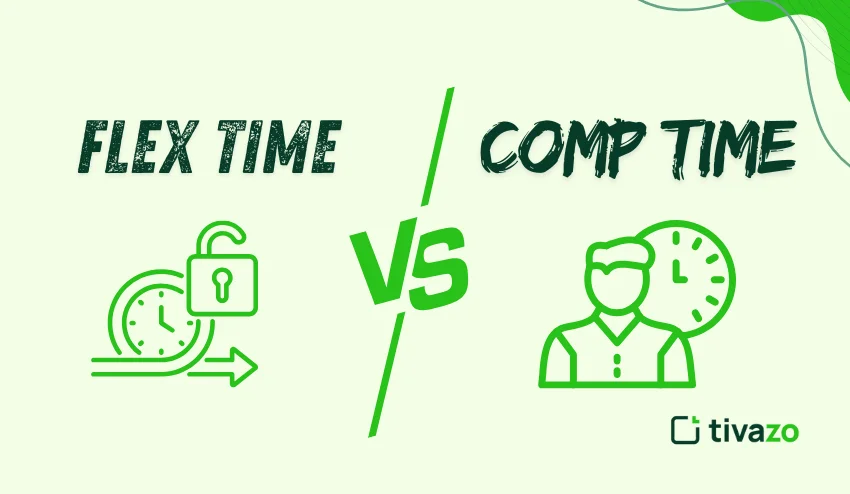Today’s workplace is constantly evolving. Companies are continuously trying to find the right balance between employee flexibility and their operational needs. Typically, forum regulation of time management for a change of employee flexibility will refer to either flex time vs comp time. But what is the difference between flex time vs comp time, and how does one gauge what is best for their employee group?
Understanding the key distinctions between flex time vs comp time will help a manager create policies that enhance productivity, improve employee satisfaction, and keep them compliant with labor laws. By discussing the definitions, advantages, and real-world examples, you can make an informed choice that fits your team and organization.
What Is Flex Time?
Flex time (sometimes shown as “flextime”) is a flexible scheduling option that allows employees to set their start and end times (within parameters), while still completing their total work hours in a day, week, or pay period.
Important aspects:
- There is usually a core time when employees need to be present (e.g., 10 a.m. to 3 p.m.).
- Outside of the core time, the employee can move up to an earlier start time or later finish time, as long as the employee fulfills all their predetermined work hours.
- The total hours (within a day or week) stay the same; it is only the timing that has changed.
- One has flexibility, but it is always within boundaries. When establishing a flex schedule, employers typically set the earliest/latest times from which they may tap for work calls (“bandwidth”), and in some cases, flexibility cannot take place without employer supervision.
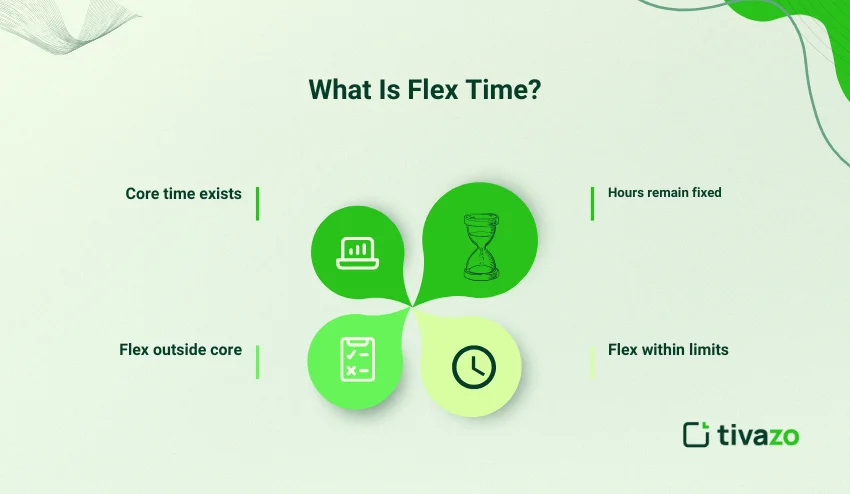
So, when you compare flex time vs comp time, flex time is about when the employee works (not receiving extra pay or time off instead).
This flexibility is predominantly usable for positions where an employee’s presence is not required at all times or where the employee can similarly stagger their work time, so it does not conflict with personal limitations but reduces peak traffic of physical presence.
Examples of Flex Time
Here are some practical examples of flexible working arrangements:
| Circumstance | Definition |
| Core Hours Model | A company requires employees to be present from 11 AM to 3 PM, with the ability to start anytime between 7 AM to 7 PM. |
| Compressed Week + Flex | Employees may work four 10-hour days with one day off, yet the employee can choose start times (8 AM to 6 PM or 9 AM to 7 PM). |
| Daily Flex | On one day, an employee may arrive at 8 AM instead of 9 AM, and leave at 5 PM instead of 6 PM due to personal needs (drop off children, doctor appointment, etc.). |
| Makeup Time | If an employee leaves a bit early one day for an appointment, they can make up time later that same day or week (within policy). |
These examples show how flex time vs comp time provides time relief without altering the overall time of total hours worked.
Benefits of Flex Time
Flex time can be beneficial for both employees and employers. Some of the main benefits include the following:
For employees:
- Better work-life balance (less in rush hour, more able to get personal tasks done)
- Higher job satisfaction and morale
- Less stress and cost of getting to work
- Ability to work when they feel most productive.
For employers:
- Better retention and commitment from employees
- Higher productivity (staff work when they are most awake)
- Easier to attract employees to jobs (flex is a desirable fringe benefit)
- Managing workload peaks (some staff can start early; some can start late)
- Less need for overtime when employees can manage their schedules.
There are also downsides to flex time, for example, making sure there is always coverage during core hours, coordinating collaboration across schedules, time-tracking, and overall visibility to individual time use.
It's essential to know what flex time vs comp time as both are crucial
What Is Comp Time?
Comp time, short for compensatory time or compensatory time off, is a system in which employees earn time off instead of overtime pay when they work over their usual hours.
Rather than pay extra cash for hours worked in the overtime range, the employer will log “comp time,” which employees can use later as paid time off.
The key characteristics of comp time are:
1. It will only take place when an employee works over their normal hours (it is, in practice, usually over 40 hours a week, more or less, depending on the employment model in the U.S.)
2. When an employee works extra time, they will accrue 1.5 hours of comp time for every hour past their normal schedule (i.e., match time and a half for overtime, but as comp time)
3. Employers must track what has been accrued for comp time, when it has been used, when it expires, and what the payout rules are.
4. It is especially common in public sector/government roles, as they also sometimes have strict legal rules for it.
5. Some employers may require employees to use their comp time within a certain period, like in the same pay period or within a year.
So, when comparing flex time vs comp time, in short, comp time compensates for hours worked with time off instead of extra pay.
Advantages of Comp Time
If managed properly, comp time can provide substantial benefits:
- Cost control: employers can avoid actual cash payment for overtime (especially important in the public sector)
- Employee flexibility: employees get extra paid time off that can be scheduled in the future
- Employee morale/example of reward: employees regard it as a reward for going above and beyond their expected hours
- Promotes use of time-off: rather than stacking the hard cash payout for overtime, employees are more likely to utilize time off
- Budget forecasting: reduces forecasting for overtime expense
When implemented and utilized effectively, comp time offers employers a good way to reward their employees in a manner that does not affect their cash flow situation, and it can be a powerful workforce management strategy. Comp time policies can also be used with flex time vs comp time policies by managers to improve employee satisfaction while enhancing the overall effectiveness of business operations.
However, there are risks: liability of accrual (a large pool of hours employees have not used), competing workforce scheduling when several employees want to use the time at the same time, legally complicated, and administratively difficult to manage.
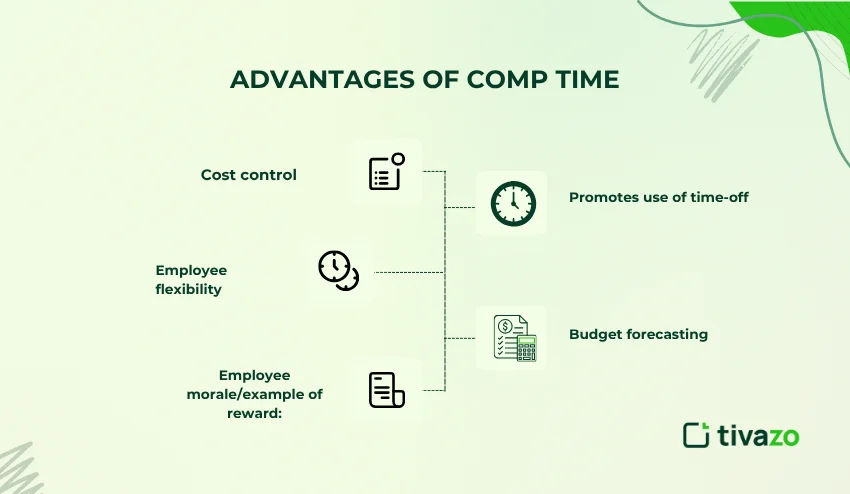
Main Differences: Comp Time vs Overtime
A lot of people ask: What is comp time vs overtime? Here are the differences:
| Aspect | Overtime | Comp Time |
| Payment | Cash, usually at 1.5 × regular rate (in many states) | Puts time off, usually at 1.5 hours taken for 1 hour overtime |
| Payment Immediately | Yes | No – this is deferred time off |
| Flexibility for employees | Not much (they have to pay) | More (they can take time off whenever they want) |
| Liability | Immediate cost to the company | Lied on books until picked or paid off |
| Legal Constraints | States require overtime pay for non-exempt employees | Limited most of the time, particularly in the private sector (states and US FLSA) |
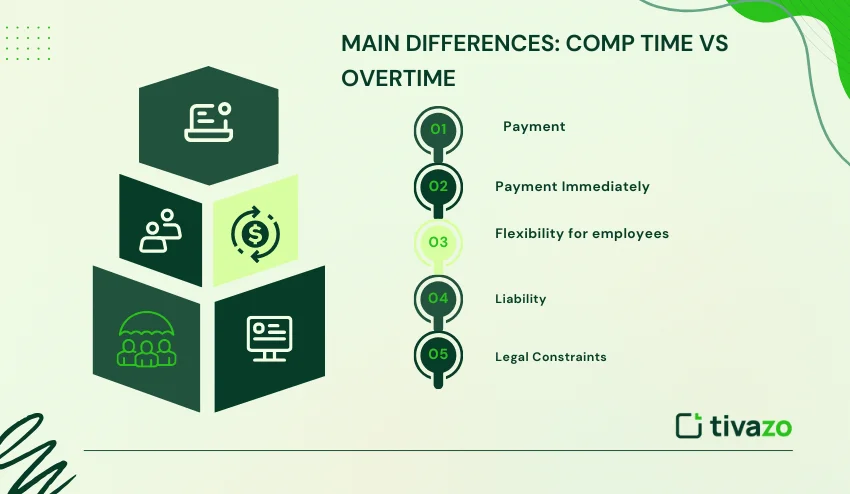
Comparison of Flex Time Vs Compensatory Time
Here’s an overview of flex time vs comp time on each important dimension:
| Dimension | Flex Time | Comp Time |
| What it affects | Timing of work (start/end or stay late / go home early) | Compensation for working extra hours (time off) |
| When it applies | Work hours are considered standard | Outside standard work hours (overtime) |
| Keyword usage | “Flex time vs comp time” as a negative comparison | Same on flex time vs comp time |
| Employee control | High control over schedule (time and coordinate personally) | Control over when to use compensatory time |
| Legal complexity | Lower complexity (unless labor law restrictions) | Higher complexity (comp time requires legal restrictions in the private sector) |
| Administrative burden | Moderate administrative burden (tracking flexible work hours) | High administrative burden (tracking accrual of time, usage, payout) |
| Liability risk | Lower risk liability | Higher risk liability (banked hours) |
| Best for | Work schedule flexibility for adjustment of any daily schedule, or a sick child, or covering for another employee | Offering an employee a reward for working late or an overnight shift in addition to their pay (non-pay) |
| Risk Requires | A lot of coordination may open gaps for coverage | Responsibility for the accrual of liability and employees, as well as being compliant/scheduling conflicts |
The takeaway of the “Flex time vs Comp time” conversation is that flex time is simpler to manage and ultimately more about flexibility in scheduling, while comp time is much more complicated but adds a benefit in that real-time rewards to a relatable employee for knowing the difference between flex time vs comp time.
Calculating Compensatory Time
Compensatory time calculations generally focus on the amount of compensated time the employee will be allowed to take for assisting an employer with non-standard hours of work. In states that allow for compensatory time, the calculations closely mirror overtime calculations. While there can be other variables in developing a comp time calculation, here is a simple version.
- Identify the overtime worked: The time above and beyond the standard (in this case, 40 hours for one work week).
- The accrual multiplier: Many comp time plans are 1.5× accrual. For each one hour worked overtime, the employer gives the employee 1.5 hours of comp time. Example: An employee has worked five hours overtime → five was the overtime assumption = 5 × 1.5 = 7.5 of comp time for the employee.
- Bank the compensatory time: The time is then added to the employer’s employee comp time banking balance of hours. Hence, keeping in mind which time to use between flex time vs comp time.
- Usage/expires: The employer tracks it if the employee uses the comp time; it is subtracted from the employee’s bank, and the employer can develop rules about when it can be used or when it can expire unused or be paid.
- Payout: If the compensatory time expires (or employment expires), the employer must convert the remaining comp time hours into cash, depending on the legal requirements or plan policy of the employer.
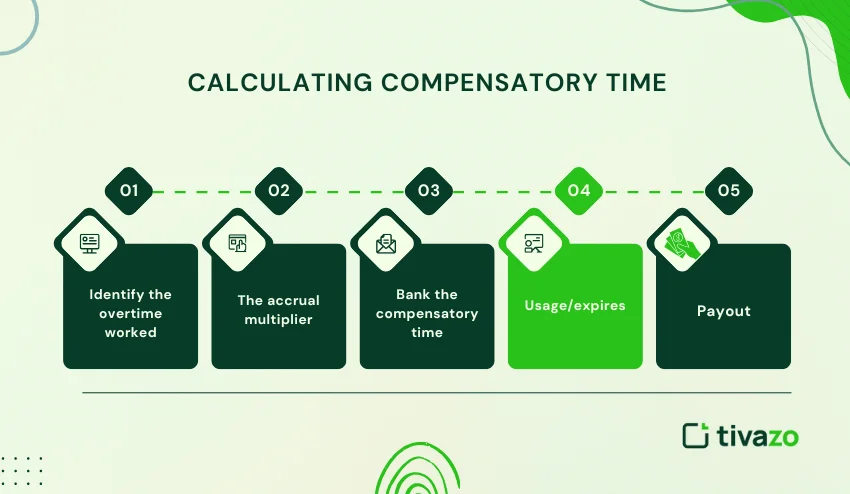
You may need to do example calculations.
- Standard hours/week = 40.
- Employee works 45 hours → subtract 40 standard hours = 5 hours overtime.
- 5 hours were used for calculation; 5 hours overtime × 1.5 comp time = 7.5 hours of compensatory time for the employee to use.
- If the employee takes time off (uses), then the employer needs to deduct from the comp balance.
How to Determine Which to Choose for Your Organization
Determining flexibility in scheduling/obtaining comp time or a combination of both is a multifaceted question. Here is a decision-making guide, and knowing flex time vs comp time:
A. Consider your workforce and the type of work
- Are employees in primarily fixed schedule roles or flexible task roles?
- Do employees require collaboration with one another on a regular basis in real-time, or can they work on tasks separately?
- Are you in an industry that requires strict coverage (e.g, customer service, shifts)?
- Do employees want flexibility in their schedule or in time off?
B. Compliance / legal checks
- Is comp time allowed in your area for your type of employees? ( Particularly for private sector non-exempt)
- Are there limits on accumulation?
- Are you required to pay comp balances on termination?
C. Administrative capacity
- Are you equipped with systems to track accrued comp, to track use, to track expiration, and cash out?
- Do you have Payroll/HR personnel and/or support to manage this effort?
D. Financial/liability perspective
- How much risk are you willing to bear of unpaid comp relationships?
- Can you afford to cash out immediately as overtime?
E. Hybrid or phased approach
You could offer flex time vs comp time to all employees, while also allowing comp time for exempt employees or those in a more senior role. You could also be selective with using comp time during selective peak seasons and use flex time vs comp time at other times.
F. Pilot & iterate (find out if it’s feasible with a pilot team)
- To start, run this process with a pilot group and evaluate employee buy-in, adoptability, and possible issues.
- Then, gain feedback from employees and the manager in terms of a plan moving forward.
For example, in the area of flex time vs comp time, organizations usually start with flex time (there are fewer moving parts) and leave comp time for specific functions or for specific reasons/circumstances.
Conclusion
When comparing flex time vs comp time, the two seem different, but they can actually work together for a more effective workplace.
Flexible time gives workers options on when work is done (within limits), actual flexibility, and a sense of work-life balance. Acknowledging flex time vs comp time.
Comp time, on the other hand, compensates employees with time away from work instead of monetary payments, though it is more complex, and it has some legal risks.
If you are deciding for your organization, on the side of flex time vs comp time (for reduced risk and easier administration), and comp time on a case-by-case basis, for those roles where it is legal, and create an advantage for the organization. Document the policy, monitor accruals, and employ stronger systems to manage tracking.
Properly designed and caution exercised, the two working together and knowing what is flex time vs comp time in this way can improve morale while managing costs and maintaining compliance.
